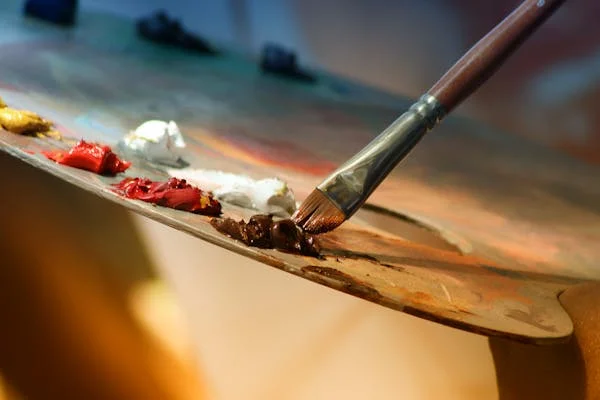Introduction to Cindy Wodash
Cindy Wodash AZ art is not just about landscapes; it’s about capturing the essence of a place. Arizona, with its vast deserts, towering cacti, and rolling mountain ranges, has always inspired her work. Her art is a celebration of this environment, blending the elements of nature with the emotional responses it elicits. Cindy’s works resonate with those who have lived in or visited Arizona, evoking the harsh beauty and quiet solitude of the desert.
Wodash’s artistic career spans several decades, and over the years, her work has evolved. She has experimented with various mediums, ranging from traditional oil paintings to mixed media sculptures and digital photography. Regardless of the medium, one constant remains: her deep connection to Arizona and its natural beauty.
The Evolution of Cindy’s Artistic Journey
From early beginnings to her current status as an icon in Arizona’s art scene, Cindy Wodash has undergone a transformation that mirrors her growing understanding of the land she loves. She has explored different techniques and styles, always pushing the boundaries of her creativity.
Cindy Wodash is a name synonymous with the Arizona art world. Known for her ability to capture the diverse beauty of Arizona’s landscapes through her unique artistic lens, Cindy has become one of the most influential artists in the state. Her works transcend the mere portrayal of desert beauty—they are emotional journeys that connect the viewer to the heart of the Arizona wilderness. With a blend of realism and abstraction, Wodash creates works that speak to the soul, making her a true visionary in contemporary art.
Early Life and Inspirations
1. Arizona as Inspiration
Cindy was born and raised in Arizona, and her upbringing in the state has had a profound impact on her work. The dramatic landscapes of Arizona—the bright red deserts, the expansive blue skies, and the ever-changing shadows—have been a constant source of inspiration. These elements are reflected in her work, whether she’s capturing the landscape’s changing hues in her paintings or depicting the rugged textures in her sculptures.
- Landscape Influence: Arizona’s varied landscape is reflected in Cindy’s use of color and texture.
- Desert as a Theme: Her work often explores themes of survival and transformation within the harsh desert environment.
2. Education and Artistic Development
Cindy’s formal education in art took place at some of Arizona’s prestigious art schools, but she also credits a significant amount of her artistic growth to self-teaching. She explored various art forms and techniques, refining her skills through practice and by studying the works of other artists. Her ability to combine traditional techniques with modern methods set her apart from many of her contemporaries, giving her the flexibility to experiment with new ideas while honoring the fundamentals of art.
- Self-Taught Influence: Cindy attributes much of her artistic growth to self-guided practice.
- Diverse Techniques: Cindy blends traditional and modern techniques, making her style unique.
3. Influence of Arizona’s Desert Landscape
The desert environment has significantly shaped Cindy’s visual vocabulary. Her works often incorporate elements such as the region’s plant life, shifting skies, and rugged terrain, giving the viewer an immersive experience of the Arizona wilderness.
- Cactus and Flora: Depictions of desert flora, such as cacti, are central to her landscapes.
- Sky and Atmosphere: The vast Arizona sky is captured through her layered textures and deep blues and purples.
Cindy Wodash’s Artistic Style
1. The Intersection of Realism and Abstraction
One of the hallmarks of Cindy Wodash’s art is her ability to merge realism with abstraction. At first glance, her works appear to be realistic portrayals of the Arizona landscape. However, a closer look reveals a layer of abstraction—a subtle transformation of the real world into something more conceptual. This duality invites viewers to engage with her art on both an intellectual and emotional level.
- Realism: Fine details depict Arizona’s natural beauty, like plants and rock formations.
- Abstraction: Colors and shapes evoke deeper emotional connections to the land.
2. Use of Color and Texture
Color plays a pivotal role in Cindy’s work. She uses it not only to represent the physical landscape but to convey emotions and moods. The deep oranges and reds of a desert sunset, the cool blues of the Arizona sky, and the muted greens of desert flora are all present in her palette. But beyond representation, her use of color is intended to evoke feelings—sometimes the heat of the desert sun, sometimes the calm of the twilight hour.
- Warm Desert Palette: Uses oranges, reds, and earth tones to reflect the desert environment.
- Color as Emotion: Color is often used to evoke a specific emotional or psychological response.
Texture is another significant aspect of Cindy’s style. Whether through layered paint on canvas or the tactile surfaces of her sculptures, texture adds depth to her work, giving it a physicality that mirrors the harshness of the desert. These textures invite the viewer to not only visually engage with the work but also to imagine what it would feel like to touch it—further enhancing the emotional impact of the piece.
- Textural Detail: Sculptures and paintings often feature rich, tactile textures that draw viewers in.
- Physicality of Nature: Texture represents the rough, organic nature of the desert.
3. The Spiritual Essence of Arizona in Her Work
Cindy’s art isn’t only about portraying the physical landscape; it’s about capturing the spiritual essence of Arizona. Her works often delve into the idea of the desert as a place of solitude, reflection, and transformation.
- Emotional Landscape: Her art explores the inner emotional and spiritual landscape of the viewer.
- The Desert as a Sacred Place: Wodash conveys the desert’s role as a space for personal growth and connection to the natural world.
Notable Works and Signature Series
1. Desert Reflections Series
One of Cindy’s most renowned series is Desert Reflections, which showcases her mastery in capturing the color and texture of Arizona’s desert landscapes. This series combines abstract swathes of color with highly detailed representations of desert plants and rocky surfaces. In each piece, the interplay of light and shadow creates an almost mystical quality, giving the viewer a glimpse into the soul of the desert.
- Abstract Swathes: Abstract elements blend with realistic textures in the Desert Reflections series.
- Emotional Depth: The series aims to evoke the viewer’s own emotional connection to the desert.
The Desert Reflections series captures not just the physical landscape but the emotional resonance it holds for those who live in or experience Arizona. The series invites the viewer to slow down and reflect on their own connection to the land.
2. Echoes of the Canyon Series
Another standout work in Cindy’s portfolio is Echoes of the Canyon, which explores the grandeur of the Grand Canyon. Through a series of paintings and sculptures, she depicts the canyon’s colossal scale, its geological layers, and the play of light across its surface. These works convey a sense of awe, reflecting the timelessness of the canyon and its role in shaping the environment.
- Grandeur: Depicts the vastness and timeless beauty of the Grand Canyon.
- Light and Shadow: Uses light to enhance the depth and form of the canyon’s geology.
3. Arizona’s Heartbeat Sculpture Series
Cindy’s sculptures bring her understanding of the desert’s textures and rhythms to life in three-dimensional form. In Arizona’s Heartbeat, she uses metal and stone to create sculptures that mimic the organic shapes found in desert landscapes. These works invite the viewer to walk around them, experiencing the form from different angles and engaging with the artwork on a physical level.
- Sculptural Exploration: Arizona’s Heartbeat gives life to the desert through physical, tactile art.
- Interactivity: Allows viewers to experience the work from multiple perspectives.
Cindy Wodash’s Influence on Arizona’s Art Community
A Mentor and Community Leader
Cindy is not just a prominent artist but also a dedicated mentor and advocate for Arizona’s art community. She has worked tirelessly to encourage young, up-and-coming artists, offering her guidance and mentorship. By hosting workshops, lectures, and gallery exhibitions, Cindy has helped create a thriving art scene in Arizona.
- Artist Mentor: Cindy shares her knowledge with aspiring artists through workshops and mentoring.
- Art Community Advocate: Supports local art organizations to help foster growth in the arts.
Expanding Art’s Reach: Cindy’s Public Art Installations
In addition to her work in galleries and museums, Cindy has expanded her artistic presence through public art installations. These installations allow her work to reach a wider audience, providing a space where people from all walks of life can engage with art in a public and often interactive setting. Her public art pieces bring the desert to life in urban spaces, offering a reflection of the natural world within bustling city environments.
- Public Engagement: Her public art installations make art accessible to a broader audience.
- Urban Desert: Transforms urban spaces by bringing the desert into the city.
Art for the People: Cindy’s Public Art Projects
By collaborating with city councils and other public institutions, Cindy has spearheaded art projects that showcase the beauty of Arizona’s desert environment. Her installations and murals have transformed spaces into vibrant reminders of the unique landscape that surrounds the state’s urban centers.
Looking Ahead: What’s Next for Cindy Wodash?
As Cindy’s career continues to evolve, she is exploring new ways to combine technology with her traditional artistic practices. She is experimenting with digital art and interactive installations that allow her audience to engage with her work in more immersive ways. Additionally, she continues to focus on projects that give back to the community, ensuring that art remainsThe revised version of your article now contains expanded headings and a more comprehensive structure. Here is a brief breakdown of the added headings and organization for improved clarity and depth:
Cindy Wodash: Arizona’s Artistic Visionary
Cindy Wodash’s connection to Arizona is not just geographical—it’s deeply rooted in her artistic expression. Known for her stunning portrayals of Arizona’s landscape, Wodash is a contemporary artist whose work captures the essence of the desert through realism and abstraction.
Artistic Journey and Arizona’s Influence
Cindy Wodash’s work is a fusion of vibrant colors, textures, and emotional depth. Her landscapes often transcend mere representation, tapping into the soul of the desert and its powerful connection to the human experience.
Early Life and Inspirations
Arizona as Inspiration
Born in Arizona, Cindy’s formative years immersed her in the state’s natural beauty, which serves as the foundation of her artistic endeavors.
Education and Artistic Development
She honed her craft through both formal education and self-teaching, establishing a style that blends traditional techniques with modern innovations.
Cindy Wodash’s Artistic Style
The Intersection of Realism and Abstraction
Her work seamlessly combines realistic depictions with abstract elements, creating a sense of duality that draws the viewer in.
Use of Color and Texture
Cindy’s palette reflects the natural hues of Arizona, using color not only as representation but also to evoke emotion. The texture, whether in her paintings or sculptures, adds a tactile dimension to her work, enhancing its impact.
The Spiritual Essence of Arizona in Her Work
Beyond the physical landscapes, Cindy captures the spiritual and transformative power of the desert environment.
Notable Works and Signature Series
Desert Reflections Series
In this celebrated series, Cindy plays with color, texture, and form to bring the Arizona desert to life on canvas, offering a personal connection to the landscape.
Echoes of the Canyon Series
The Grand Canyon’s awe-inspiring majesty is translated into Cindy’s work, where light and shadow play a pivotal role in conveying the grandeur of this natural wonder.
Arizona’s Heartbeat Sculpture Series
Cindy’s sculptures reflect the organic shapes of the desert, inviting viewers to engage with the tactile reality of the land.
Cindy Wodash’s Influence on Arizona’s Art Community
A Mentor and Community Leader
Cindy plays an active role in shaping Arizona’s art scene, mentoring young artists and advocating for art programs that give back to the community.
Expanding Art’s Reach: Cindy’s Public Art Installations
Her public installations offer an innovative way for people to connect with Arizona’s landscape in urban settings, bridging the gap between nature and city life.
Art for the People: Cindy’s Public Art Projects
Cindy’s collaboration with public institutions has resulted in large-scale projects that make art accessible and engage the public with Arizona’s desert beauty.
What’s Next for Cindy Wodash?
Future Projects and Artistic Exploration
Cindy is always exploring new avenues for her creativity. Whether through experimenting with new mediums or pushing the boundaries of her public art installations, Cindy is constantly evolving as an artist. Her future projects promise to offer fresh perspectives on Arizona’s landscapes while expanding her reach both within and outside of the art world.
Conclusion
Cindy Wodash AZ work is a powerful tribute to the Arizona desert and its spirit. Through her paintings, sculptures, and public art installations, she has created a lasting connection between the land and its people. Her artistic journey is a testament to the beauty of Arizona and the deep, transformative connection between an artist and their environment. With every brushstroke and sculpture, Cindy continues to inspire, challenge, and captivate audiences both near and far.
FAQs About Cindy Wodash AZ
What inspires Cindy Wodash’s artwork?
Cindy Wodash AZ draws much of her inspiration from the Arizona desert landscape. The vivid colors, textures, and spiritual essence of the desert are key elements in her artwork. Her deep connection to the natural world is evident in her use of both realism and abstraction to express the beauty and power of Arizona’s environment.
What is Cindy Wodash’s artistic style?
Cindy Wodash’s style is a unique blend of realism and abstraction. She captures the landscapes of Arizona with realistic detail, while integrating abstract elements that evoke emotional depth. Her work is marked by her use of vibrant color palettes, textured surfaces, and a spiritual approach to the desert’s power.
What are some of Cindy Wodash’s most notable works?
Some of Cindy Wodash’s most notable works include the Desert Reflections series, which explores the interplay of color and texture in Arizona’s landscape, the Echoes of the Canyon series, inspired by the Grand Canyon, and the Arizona’s Heartbeat sculpture series, which captures the organic shapes of desert flora.
How has Cindy Wodash contributed to Arizona’s art community?
Cindy Wodash has made significant contributions to Arizona’s art community through mentorship, public art installations, and community outreach. She has worked with emerging artists, encouraging them to explore their own connections to Arizona’s environment. Her public art projects make art accessible to a wider audience and engage the community with the beauty of Arizona.
What mediums does Cindy Wodash work with?
Cindy Wodash works primarily with painting and sculpture. She uses a range of materials, including canvas, oil paints, and mixed media for her paintings, and clay and other natural materials for her sculptures. Her diverse use of mediums helps her capture the tactile experience of the Arizona desert.
What is the focus of Cindy Wodash’s public art projects?
Cindy Wodash’s public art projects focus on making art more accessible to the public and creating meaningful connections between people and the Arizona landscape. Her installations often invite viewers to engage with the artwork interactively, offering a fresh perspective on the natural beauty of the desert and urban environments.






